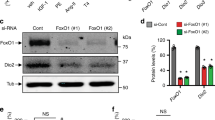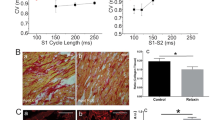Abstract
It has previously been shown that thyroid hormone can reverse cardiac remodeling in failing hearts by reducing myocardial wall stress due to the unique changes induced in cardiac myocyte shape. This effect may be of therapeutic relevance. Therefore, the present study has investigated potential signaling mechanisms underlying the thyroid hormone action on cardiac myocyte shape and geometry. Neonatal cardiomyocytes were treated with T3 while untreated cells served as controls. T3 administration for 48 h significantly increased the ratio of the major to minor cell axis and changed their shape from an almost circular to an elongated form. Cell area and protein synthesis were increased and T3 treated cells expressed 51% α-MHC and 49% β-MHC as compared to 100% β-MHC expression in non-treated cells. This response was accompanied by a 1.9-fold increase in phospho-ERK levels early at 8 min which, within 60 min, returned to the levels of the untreated cells. Phospho-JNK levels were significantly reduced within 60 min after T3 treatment while no changes in the expression of phospho-Akt and phospho-p38 MAPK were found between the T3 treated and untreated cells. Administration of PD98059 (an inhibitor of ERK signaling) prevented the thyroid hormone induced changes in cardiomyocyte geometry and shape without a significant reduction in cell area and protein synthesis. In conclusion, T3 induced changes in cardiomyocyte shape and geometry involve the ERK kinase signaling. This response is independent of the effects of T3 on cell size and protein synthesis.
Similar content being viewed by others
References
Kinugawa K, Yonekura K, Ribeiro RC, Eto Y, Aoyagi T, Baxter JD, Camacho SA, Bristow MR, Long CS, Simpson PC (2001) Regulation of thyroid hormone receptor isoforms in physiological and pathological cardiac hypertrophy. Circ Res 89(7): 591–598
Pantos C, Mourouzis I, Saranteas T, Paizis I, Xinaris C, Malliopoulou V, Cokkinos DV (2005) Thyroid hormone receptors alpha1 and beta1 are downregulated in the post-infarcted rat heart: consequences on the response to ischemia-reperfusion. Bas Res Cardiol 100(5): 422–432
Pingitore A, Landi P, Taddei CM, Ripoli A, L’Abatte A, Iervasi G (2005) Triiodothyronine levels for risk stratification of patients with chronic heart failure. Am J Med 118: 132–136
Morkin E, Ladenson P, Goldman S, Adamson C (2004) Thyroid hormone analogs for treatment of hypercholesterolemia and heart failure: past, present and future prospects. J Mol Cell Cardiol 37: 1137–1146
Ojamaa K, Kenessey A, Shenoy R, Klein I (2000) Thyroid hormone metabolism and cardiac gene expression after acute myocardial infarction in the rat. Am J Physiol 279(6): E1319–E1324
Pantos C, Malliopoulou V, Varonos D, Cokkinos DV (2004) Thyroid hormone and phenotypes of cardioprotection. Basic Res Cardiol 99: 101–120
Thomas TA, Kuzman JA, Anderson BE, Andersen SM, Schlenker EH, Holder MS, Gerdes AM (2005) Thyroid hormones induce unique and potentially beneficial changes in cardiac myocyte shape in hypertensive rats near heart failure. Am J Physiol 288(5): H2118–H2122
Gerdes AM (2002) Cardiac myocyte remodeling in hypertrophy and progression to failure. J Card Fail 8(6 Suppl): S264–S268
Milani RV, Lavie CJ, Mehra MR, Ventura HO, Kurtz JD, Messerli FH (2006) Left ventricular geometry and survival in patients with normal left ventricular ejection fraction. Am J Cardiol 97(7):959–963
Douglas PS, Morrow R, Ioli A, Reichek N (1989) Left ventricular shape, afterload and survival in idiopathic dilated cardiomyopathy. JACC 13(2):311–315
Pantos C, Mourouzis I, Malliopoulou V, Paizis I, Tzeis S, Moraitis P, Sfakianoudis K, Varonos DD, Cokkinos DV (2005) Dronedarone administration prevents body weight gain and increases tolerance of the heart to ischemic stress: a possible involvement of thyroid hormone receptor alpha1. Thyroid 15(1): 16–23
Detillieux KA, Meij JT, Kardami E, Cattini PA (1999) alpha1-Adrenergic stimulation of FGF-2 promoter in cardiac myocytes and in adult transgenic mouse hearts. Am J Physiol 276(3 Pt 2): H826–H833
Gosteli-Peter MA, Harder BA, Eppenberger HM, Zapf J, Schaub MC (1996) Triiodothyronine induces over-expression of alpha-smooth muscle actin, restricts myofibrillar expansion and is permissive for the action of basic FGF and IGF-I in adult rat cardiomyocytes. J Clin Invest 98(8): 1737–1744
Pantos C, Malliopoulou V, Mourouzis I, Moraitis P, Tzeis S, Thempeyioti A, Paizis I, Cokkinos AD, Carageorgiou H, Varonos D, Cokkinos DV (2003) Involvement of p38 MAPK and JNK in the heat stress induced cardioprotection. Basic Res Cardiol 98: 158–164
Pantos C, Malliopoulou V, Paizis I, Moraitis P, Mourouzis I, Tzeis S, Karamanoli E, Cokkinos DD, Carageorgiou H, Varonos D, Cokkinos DV (2003) Thyroid hormone and cardioprotection; study of p38 MAPK and JNKs during ischemia and at reperfusion in isolated rat heart. Mol Cell Biochem 242: 173–180
Lai J, Jin H, Yang R, Winer J, Li W, Yen R, King KL, Zeigler F, Ko A, Cheng J, Bunting S, Paoni NF (1996) Prostaglandin F2 alpha induces cardiac myocyte hypertrophy in vitro and cardiac growth in vivo. Am J Physiol 271(6 Pt 2): H2197–H2208
Reiser PJ, Kline WO (1998) Electrophoretic separation and quantitation of cardiac myosin heavy chain isoforms in eight mammalian species. Am J Physiol 274(3 Pt 2): H1048–H1053
Xinaris C, Mourouzis I, Carageorgiou X, Pantos C, Cokkinos DV (2006) Differential activation of stress kinase sigmaling by phenylephrine and thyroid hormone in neonatal cardiomyocytes. J Mol Cell Cardiol 40(6): 217 (Abstract)
Okoshi MP, Yan X, Okoshi K, Nakayama M, Schuldt AJ, O’Connell TD, Simpson PC, Lorell BH (2004) Aldosterone directly stimulates cardiac myocyte hypertrophy. J Card Fail 10(6): 511–518
Xinaris C, Mourouzis I, Pantos C, Cokkinos DV (2006) Thyroid hormone promotes cardiac myocyte plasticity via activation of stress kinase signalling. J Mol Cell Cardiol 40(6): 218, (Abstract)
Kenessey A, Ojamaa K: Thyroid hormone stimulates protein synthesis in the cardiomyocyte by activating the Akt-mTOR and p70S6K pathways. J Biol Chem, http://www.jbc.org/cgi/doi/10.1074/jbc.M512671200 (May 2006)
Davis FB, Mousa SA, O’Connor L, Mohamed S, Lin HY,Cao JH, Davis PJ (2004) Proangiogenic action of thyroid hormone is fibroblast factor -dependent and is initiated at the cell surface. Circ Res 94: 1500–1506
Rubinfeld H, Seger R (2005) The ERK cascade: a prototype of MAPK signaling. Mol Biotechnol 31(2): 151–174(Review)
Yellon DM, Opie LH (2006) Postconditioning for protection of the infarcting heart. Lancet 367(9509): 456–458
Pantos C, Malliopoulou V, Mourouzis I, Karamanoli E, Paizis I, Steimberg N, Varonos D, Cokkinos DV (2002) Long-term thyroxine administration protects the heart in a similar pattern as ischemic preconditioning. Thyroid 12: 325–329
Zinman T, Shneyvays V, Tribulova N, Manoach M, Shainberg A (2006) Acute, nongenomic effect of thyroid hormones in preventing calcium overload in newborn rat cardiocytes. J Cell Physiol 207(1): 220–31
Pantos C, Malliopoulou V, Mourouzis I, Karamanoli E, Moraitis P, Tzeis S, Paizis I, Carageorgiou H, Varonos D, Cokkinos DV (2003) Thyroxine pretreatment increases basal myocardial HSP27 expression and accelerates translocation and phosphorylation of this protein upon ischemia. Eur J Pharmacol 478: 53–60
Acknowledgments
“S. NIARXOS” and “Kavalis” Foundations for supporting this piece of research.
Author information
Authors and Affiliations
Corresponding author
Rights and permissions
About this article
Cite this article
Pantos, C., Xinaris, C., Mourouzis, I. et al. Thyroid hormone changes cardiomyocyte shape and geometry via ERK signaling pathway: Potential therapeutic implications in reversing cardiac remodeling?. Mol Cell Biochem 297, 65–72 (2007). https://doi.org/10.1007/s11010-006-9323-3
Received:
Accepted:
Published:
Issue Date:
DOI: https://doi.org/10.1007/s11010-006-9323-3




